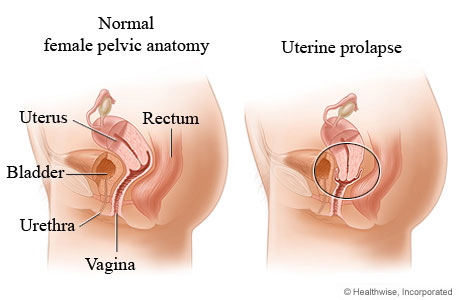Uterine prolapse

A uterine prolapse occurs when the muscles and tissues that hold the uterus in place get weak or damaged. This can cause the uterus to move from its normal position and press down into the vagina.
How can you care for uterine prolapse?
- Do not do activities that put pressure on your pelvic muscles. This includes heavy lifting and straining.
- Try exercises to tighten and strengthen your pelvic muscles. These are called Kegel exercises. (If doing these exercises causes pain, stop doing them and talk with your doctor.) To do them:
- Squeeze your muscles as if you were trying not to pass gas. Or squeeze your muscles as if you were stopping the flow of urine. Your belly, legs, and buttocks shouldn't move.
- Hold the squeeze for 3 seconds, then relax for 5 to 10 seconds.
- Start with 3 seconds, then add 1 second each week until you are able to squeeze for 10 seconds.
- Repeat the exercise 10 times a session. Do 3 to 8 sessions a day.
- Talk with your doctor about a vaginal pessary. This is a device that you put in your vagina to support the uterus. Your doctor can teach you how and when to remove it. You will also learn how to clean it and put it back in.
- If your doctor prescribes estrogen cream for your vagina, use it exactly as prescribed.
- To relieve pressure on your vagina, lie down and put a pillow under your knees. Or you can lie on your side and bring your knees up to your chest.
- If you are overweight, talk to your doctor about safe ways to lose weight.
©2011-2026 Healthwise, Incorporated
The content above contains general health information provided by Healthwise, Incorporated, and reviewed by its medical experts. This content should not replace the advice of your healthcare provider. Not all treatments or services described are offered as services by us. For recommended treatments, please consult your healthcare provider.
